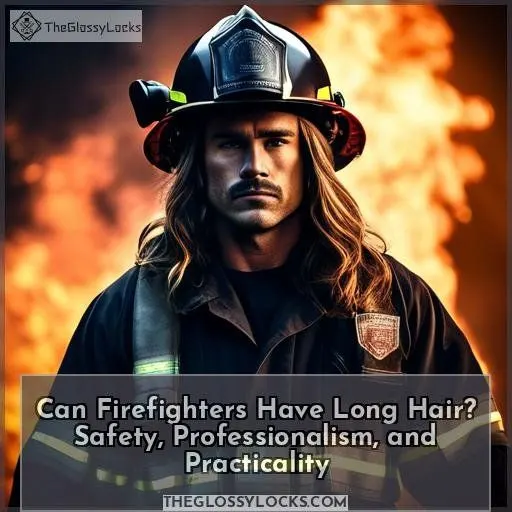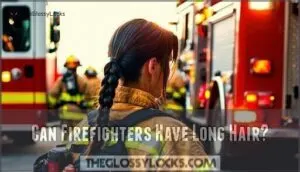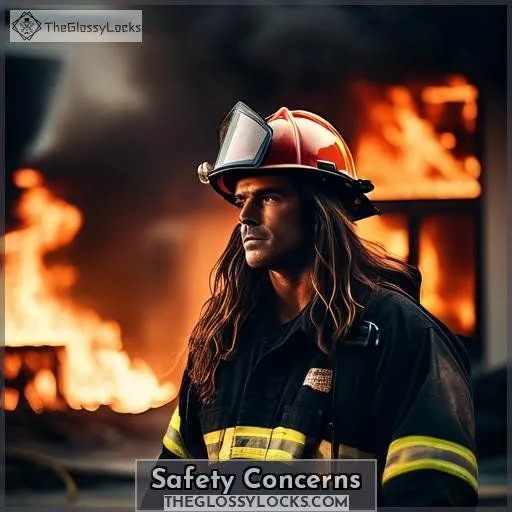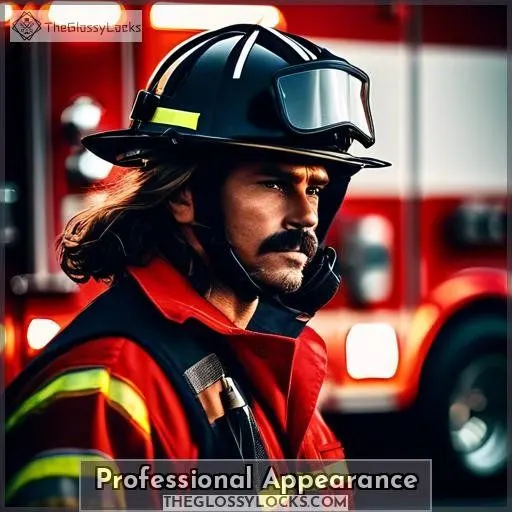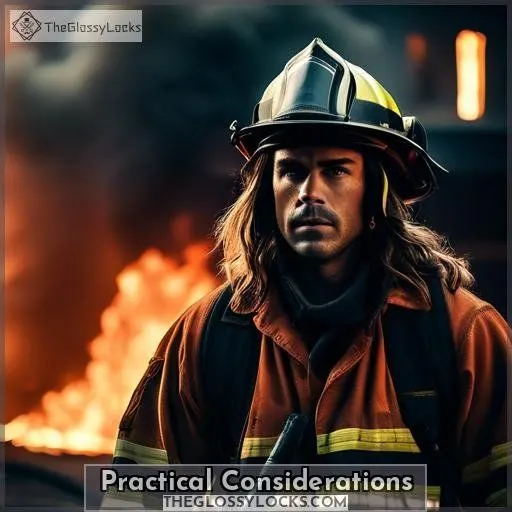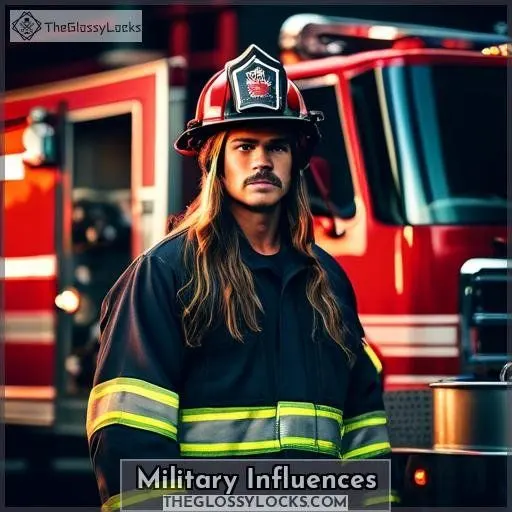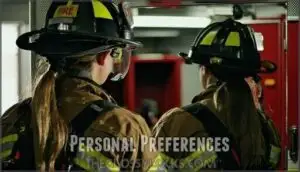This site is supported by our readers. We may earn a commission, at no cost to you, if you purchase through links.
While long hair may be a personal preference, fire departments often restrict it due to safety concerns. Long hair can get caught in equipment, obstruct protective gear, and increase injury risk during operations. It can also impact professional appearance, undermining the uniformity and public perception of firefighters.
However, the debate continues as some argue that appearance shouldn’t be a barrier to entry. Ultimately, each department must balance safety, professionalism, and personal choice.
Table Of Contents
- Key Takeaways
- Can Firefighters Have Long Hair?
- Safety Concerns
- Professional Appearance
- Practical Considerations
- Military Influences
- Personal Preferences
- Frequently Asked Questions (FAQs)
- What is the typical hair length limit for firefighters with long hair?
- Can female firefighters have long hair without restraint or pinning?
- What are the consequences for firefighters who refuse to cut their hair?
- How do grooming policies for firefighters vary between career and volunteer departments?
- Are there any legal precedents that support the right of firefighters to have long hair?
- Conclusion
Key Takeaways
Key Takeaways:
- Fire departments often restrict long hair due to safety concerns, as it can get caught in equipment, obstruct protective gear, and increase injury risk during operations.
- Long hair can impact professional appearance, potentially undermining the uniformity and public perception of firefighters.
- However, the debate continues as some argue that appearance shouldn’t be a barrier to entry for firefighters.
- Each department must balance safety, professionalism, and personal choice, and grooming standards are in place to mitigate these risks.
Can Firefighters Have Long Hair?
Yes, firefighters can have long hair, but it must be kept neat, clean, and not interfere with their personal protective equipment. The length of hair allowed varies by department, but it generally can’t exceed 2 inches in thickness and shouldn’t extend below the bottom of the ear for men.
Women may be allowed to have longer hair if it can be restrained or worn up. The NFPA guidelines often advocate for a clean-shaven approach due to safety concerns, but individual departments may have different policies.
Safety Concerns
As a firefighter, you need to be aware of the safety risks posed by long hair. Long hair can easily get entangled in equipment and obstruct protective gear, potentially elevating the risk of injury during operations.
Long Hair Can Get Caught in Equipment
Long hair can pose a significant risk to firefighters. It can get caught in equipment, compromising safety during operations. This includes air masks and protective gear, which are essential for maintaining a safe environment.
This risk isn’t limited to operational duties; it also affects patient interaction and can lead to potential injury.
Grooming standards are in place to mitigate these risks, ensuring that firefighters, regardless of gender, maintain a safe and professional appearance.
Interfere With Protective Gear
Long hair can pose safety concerns for firefighters. It can interfere with protective gear, such as helmets and air masks, and create a risk of entanglement with ropes and rigging equipment.
This can lead to increased safety risks during operations, as long hair can get caught in equipment and potentially cause accidents. It’s essential for firefighters to maintain a professional appearance and adhere to safety standards to guarantee their own safety and that of those they serve.
Increase Risk of Injury During Operations
As a firefighter, your long hair can pose a risk during operations. Here are three reasons why:
- Hair entanglement: Long hair can get caught in ropes and rigging equipment, putting you at risk of injury.
- Mask compatibility: Long hair can interfere with the seal on your respiratory protection equipment (RPE), compromising your safety.
- Heat retention: Long hair can retain heat, making it difficult to stay cool during strenuous activities.
These risks aren’t worth the gamble. Keep your hair short and manageable to safeguard your safety and the safety of those around you.
Professional Appearance
As a firefighter, your appearance contributes to the uniformity and esprit de corps of your fire service. Maintaining a professional look also shapes the public’s perception of you as a capable and trustworthy emergency responder.
Uniformity and Esprit De Corps
After tackling the hairy issue of safety, let’s delve into the core of uniformity and esprit de corps. Firefighting isn’t just about combating blazes; it’s steeped in traditions that nurture a sense of belonging.
Embracing cultural differences and gender equality, while maintaining a professional appearance, strengthens public trust. Yet, it’s a fine line between tradition and adapting to contemporary health risks.
Perception of Firefighters as Professionals
Perception of Firefighters as Professionals (Professional Appearance)
As a firefighter, your appearance plays a pivotal role in how the public perceives you. Here are some key points to bear in mind:
- Public Perception: Your hair length can influence how people view you and your profession.
- Gender Norms: Long hair may not be seen as professional for male firefighters, but it’s more accepted for women.
- Cultural Trends: Some cultures may view long hair as a sign of strength or spirituality.
- Personal Expression: Your hair can be a form of self-expression, but it shouldn’t compromise safety.
- Individual Preferences: Ultimately, your choice of hair length should align with your personal preferences and comfort.
Practical Considerations
Concerning practical factors, shorter hair may be more convenient and compatible with air masks. Additionally, less hair can aid in keeping firefighters cooler during the summer and mitigate the risk of entanglement in equipment.
Comfort and Compatibility With Air Masks
As a firefighter, your safety and comfort are paramount. To avoid these issues, consider a shorter hairstyle or use protective hair products.
Long hair can cause scalp irritation, hair loss, and damage. It can also absorb sweat, reducing visibility.
You’ll need to make sure that your hair doesn’t interfere with your air masks. Remember, safety should always be your top priority.
Cooler in the Summer
During the hot summer months, a hairstyle that keeps you cool is a must. Short haircuts like buzz cuts or pixie cuts can be a great choice for firefighters. They allow for better sweat absorption and sun protection, which is essential when working in the heat.
Plus, they’re easier to manage during summer activities and reduce the risk of hair getting caught in equipment.
Less Hair for Patients or Kids to Grab Onto
Long hair can pose a problem when dealing with patients or kids who may grab onto it. Here are four reasons why shorter hair is preferred in the fire service:
- Safety: Long hair can get caught in equipment, increasing the risk of injury during operations.
- Patient Care: Shorter hair makes it easier to provide care without the risk of getting tangled.
- Kid-Friendly: Children may grab onto long hair, which can be uncomfortable or even dangerous.
- Professionalism: A neat appearance is important for maintaining a professional image as a firefighter.
Less Hair to Get Caught in Equipment
Moving from the hassle of keeping hair out of reach from curious hands, let’s explore another practicality: avoiding the entanglement in equipment. Imagine your hair as a free spirit that, unfortunately, doesn’t mix well with the gears and gadgets of firefighting.
Keeping it short or neatly tied back isn’t just about looking sharp; it’s about ensuring your safety and efficiency on the job.
Military Influences
Military regulations have influenced firefighter grooming standards in several ways. For example, the military has strict hair length regulations for personnel who use masks, such as firefighters. These regulations guarantee that the mask creates a seal on the face, preventing air from coming in and providing a clean flow of oxygen. If a beard causes a barrier between the mask and face, even the smallest gap could mean inhalation of deadly chemicals, debris, and particles.
Gender norms have also played a role in these regulations. Historically, military-style short hair was considered the standard for men, while women were allowed to have longer hair, but leave-in conditioner options have expanded the range of hair care choices for men in recent years. However, as society has become more accepting of diverse appearances, some fire departments have adopted more flexible grooming standards, allowing women to have long hair if it’s restrained or pinned up during duty hours.
Public perception and cultural influences have also impacted these regulations. Firefighters are often seen as part of a paramilitary service, and a uniform appearance can convey professionalism and discipline. However, as the fire service becomes more diverse and inclusive, there’s a growing recognition that appearance shouldn’t be a barrier to entry for potential firefighters.
Personal Preferences
As a firefighter, you may appreciate the ease of managing short hair. The lack of hair to cut and a more polished, professional appearance above the collar can be added benefits of keeping your hair neatly groomed.
Lack of Hair to Cut
Embrace the convenience of short haircuts for firefighters. Grooming becomes a breeze, and style is effortless. With less hair to manage, you can focus on your professional duties. Individuality is still yours to claim, as the choice of haircut is a personal one. Upkeep is simplified, allowing you to spend less time on grooming and more on your firefighting career.
Easier to Manage
Firefighters with short hair can enjoy the convenience of managing their hair with ease. Here’s how:
- Braiding Techniques: Short hair allows for quick and easy braiding, perfect for keeping hair out of the way during operations.
- Hair Extensions: No more waiting for long hair to grow; hair extensions can be added to short hair for a quick and easy style change.
- Hair Color: Short hair makes it easier to experiment with different hair colors without the commitment of growing it out.
- Hair Accessories: With short hair, hair accessories like headbands, barrettes, and hair ties are more effective and less likely to get tangled. Plus, they’re easier to remove when needed.
Short hair also means less time spent on hair care, like washing, conditioning, brushing, trimming, and styling. And for those experiencing hair loss, shorter hair can be a practical solution to maintain a neat appearance.
More Professional Appearance
As we explore the topic of ‘Enhanced Professional Appearance‘, it’s essential to acknowledge that hygiene standards and scalp health play a critical role in maintaining a professional image. Long hair can sometimes be perceived as a sign of unkemptness, which may hinder public perception.
Hair length regulations and image guidelines exist to guarantee that firefighters project a clean, tidy, and professional appearance. A well-groomed look not only improves the firefighter’s image but also contributes to fostering a sense of unity and camaraderie within the team.
Neatly Groomed Above the Collar
Keeping your hair neatly groomed above the collar isn’t just about ticking boxes for appearance standards; it’s a nod to practicality and sidestepping gender norms. Whether it’s a sharp crew cut or a slicked-back style, personal expression through hair length and style variations can still shine. Just remember, in the heat of the action, practical trumps fashionable every time.
Frequently Asked Questions (FAQs)
What is the typical hair length limit for firefighters with long hair?
Firefighters with long hair can typically keep it trimmed to the bottom of their collar for a neat, professional appearance that won’t interfere with their protective equipment.
Can female firefighters have long hair without restraint or pinning?
You can don that Rapunzel ‘do, sister! As long as it’s tucked away safely, the FRS will let you rock that luscious mane on the job. Just keep it tidy and outta harm’s way, ya hear?
What are the consequences for firefighters who refuse to cut their hair?
If you refuse to comply with grooming standards, you could face disciplinary action, including reassignment or even termination. Fire departments prioritize safety, so they won’t compromise policies that protect firefighters and the public.
How do grooming policies for firefighters vary between career and volunteer departments?
You’d think fire departments would be lenient on grooming, but alas, they can be stricter than a drill sergeant! Volunteer crews may be more relaxed, while career firefighters must toe a tighter line.
Are there any legal precedents that support the right of firefighters to have long hair?
While fire departments have discretion over grooming policies, firefighters may challenge restrictions on long hair through legal claims like religious freedom or sex discrimination. The courts have issued mixed rulings on this issue.
Conclusion
Ultimately, the debate over whether firefighters can have long hair boils down to a delicate balance. While safety and professional appearance remain paramount, departments must also consider practical realities and personal preferences.
As the blazes continue to rage, a pragmatic approach that weighs all factors is key. The true mark of a firefighter lies in their courage, skill, and unwavering commitment to protecting their community, regardless of hairstyle.
Whether a firefighter sports a sleek buzz or luxurious locks, the focus should be on their ability to effectively perform their duties and serve their community.

